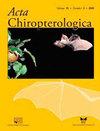Ethogram of Ghost Bat (Macroderma gigas) Behaviours and Associated Social Vocalisations
IF 0.7
4区 生物学
Q4 ZOOLOGY
引用次数: 0
Abstract
The ghost bat (Macroderma gigas) is a carnivorous species of bat endemic to northern Australia that roosts in colonies of up to 1,500 individuals. The ghost bat produces a number of social vocalisations, but little is known about the species' behaviour and what role social vocalisations play in interactions between conspecifics. The aim of this study was to construct an ethogram of ghost bat behaviours and to determine the associations between behaviours and social vocalisations. To achieve our aims, we filmed the behaviour of a captive ghost bat colony (one male, five females) using four trail cameras installed within the enclosure over a six-week period, coinciding with the estimated mating season. Video recordings were examined by eye, and solitary and social behaviours were catalogued into distinct behavioural units (e.g. hang-alert, chew, wing-groom, etc.) along with social context and associated social vocalisations, if applicable. To assess the associations between behavioural interactions and social vocalisation types, we combined each of the catalogued social behavioural units into six behavioural classes (eating, grooming, mating, huddling, flying, and fighting) and used generalised linear models to determine which social behavioural classes significantly predicted the production of each vocalisation. There was a strong association between flight behaviour by a member of the colony and the production of the ‘Chirp-trill’ vocalisation by the male member of the colony, suggesting a territorial or mate attraction function. There was also a strong association between fighting behaviour and the production of the ‘Squabble’, ‘Rasp’ and ‘Grumble’ vocalisations, with the Squabble and Rasp likely representing levels of agonistic vocalisations produced by aggressive bats during altercations. The Grumble, on the other hand, was produced by the target of the aggressor and so may function as an appeasement call. The ethogram with its associated social vocalisations provides a formal basis for future behavioural studies in this species and can serve as a template for such studies in other echolocating bats. Our study revealed an unexpected degree of complexity in the behaviour and associated vocalisations in this species and highlights the need for studies of this kind in other bats.鬼蝙蝠(Macrodema gigas)行为的民族志及相关的社会发声
鬼蝙蝠(Macrodema gigas)是澳大利亚北部特有的一种食肉蝙蝠,栖息在多达1500只蝙蝠的群落中。鬼蝙蝠产生了许多社会发声,但人们对该物种的行为以及社会发声在同种之间的互动中扮演的角色知之甚少。本研究的目的是构建鬼蝙蝠行为的行为图,并确定行为与社会发声之间的联系。为了实现我们的目标,我们使用安装在围栏内的四台跟踪摄像机,在六周的时间里拍摄了一个圈养鬼蝙蝠群落(一只雄性,五只雌性)的行为,这与估计的交配季节相吻合。通过眼睛检查视频记录,将孤独和社交行为与社会背景和相关的社会发声(如适用)一起编目为不同的行为单元(如悬挂警报、咀嚼、梳理翅膀等)。为了评估行为互动和社会发声类型之间的关联,我们将每个分类的社会行为单元组合成六个行为类别(进食、梳理、交配、挤在一起、飞行和打斗),并使用广义线性模型来确定哪些社会行为类别显著预测了每种发声的产生。群体成员的飞行行为与群体男性成员发出的“啁啾颤音”之间存在着强烈的联系,这表明群体具有领土或配偶吸引功能。打斗行为与“Squabble”、“Rasp”和“Grumble”叫声的产生也有着密切的联系,Squabble和Rasp可能代表了攻击性蝙蝠在争吵中发出的痛苦叫声的水平。另一方面,Grumble是由侵略者的目标制造的,因此可能起到绥靖的作用。行为图及其相关的社会发声为该物种未来的行为研究提供了正式的基础,并可以作为其他回声定位蝙蝠此类研究的模板。我们的研究揭示了该物种行为和相关发声的复杂性,并强调了对其他蝙蝠进行此类研究的必要性。
本文章由计算机程序翻译,如有差异,请以英文原文为准。
求助全文
约1分钟内获得全文
求助全文
来源期刊

Acta Chiropterologica
生物-动物学
CiteScore
2.50
自引率
20.00%
发文量
42
审稿时长
>12 weeks
期刊介绍:
Acta Chiropterologica, published by the Museum and Institute of Zoology at the Polish Academy of Sciences, is devoted solely to the study and discussion of bats.
 求助内容:
求助内容: 应助结果提醒方式:
应助结果提醒方式:


